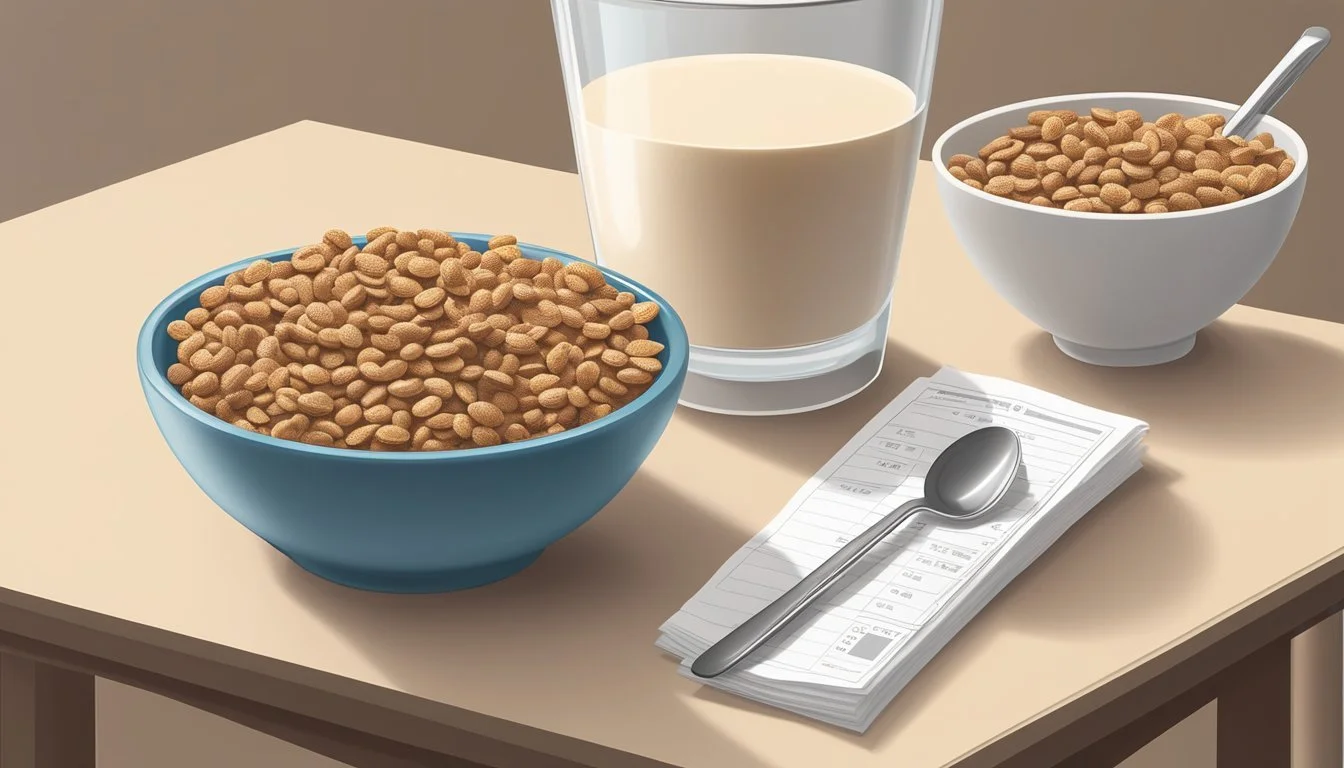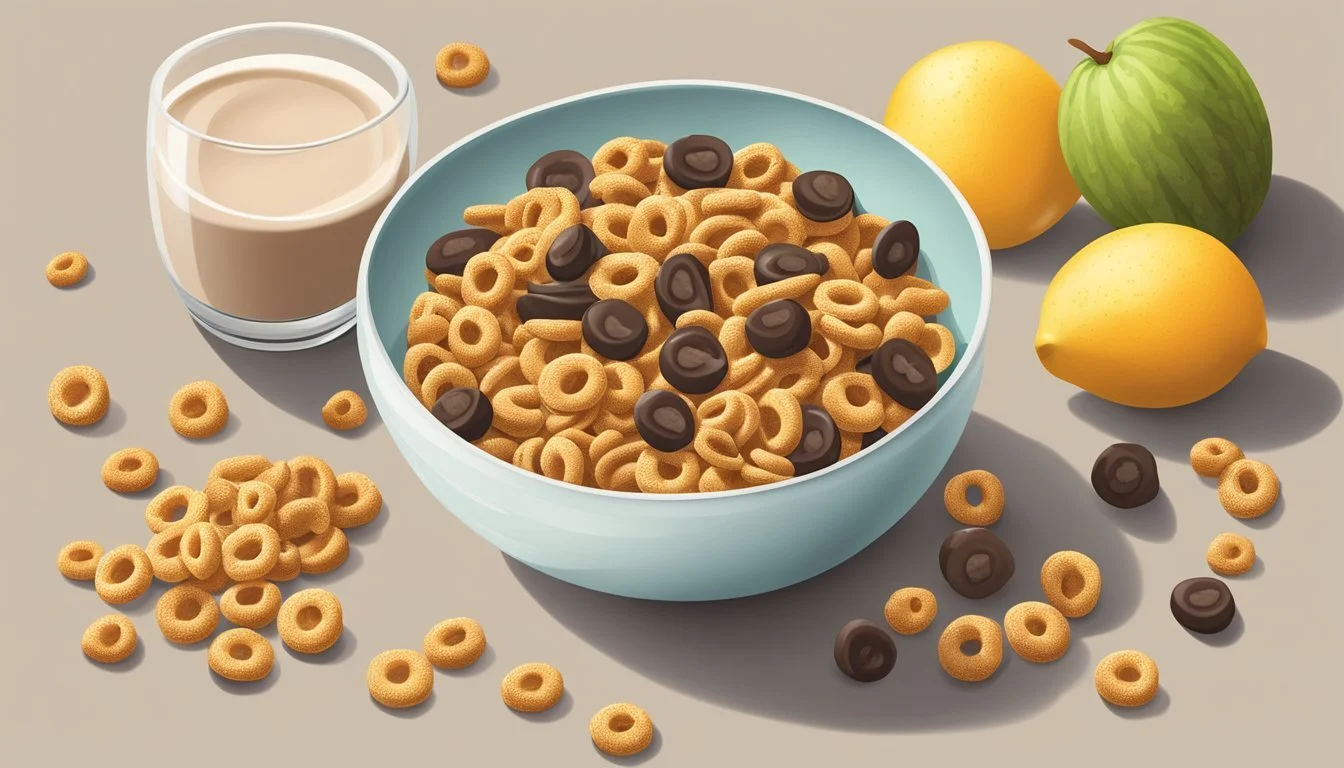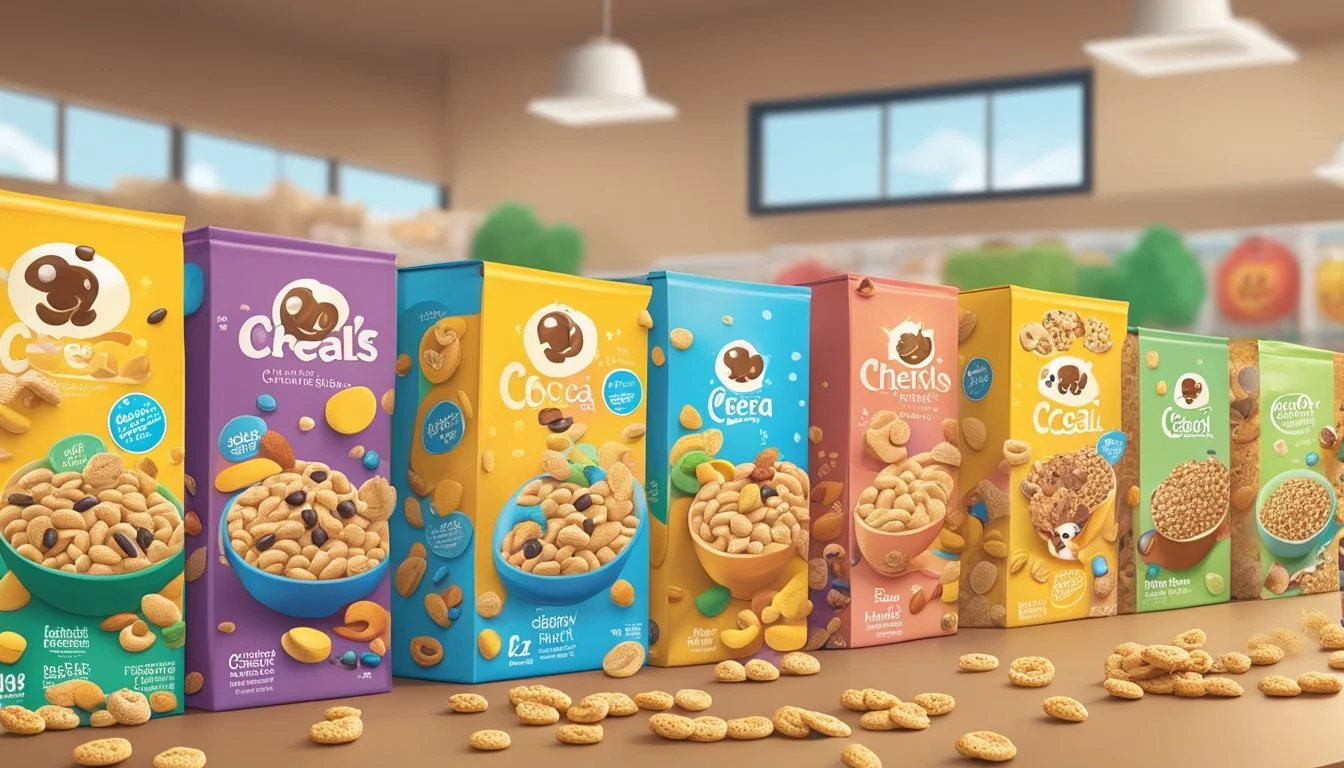Cheerios vs Cocoa Pebbles
Comparing Nutritional Value and Taste
This Article is Part of Our Breakfast Cereal Guide with Details on Cheerios Nutrition and Cocoa Pebbles Nutrition
When it comes to choosing between Cheerios and Cocoa Pebbles, dietary preferences and nutritional content often influence the decision. Cheerios, a staple in many households, offers a variety of flavors ranging from classic to more adventurous options like Pumpkin Spice. Their appeal lies in their versatility and relatively balanced nutritional profile, making them a favored choice for health-conscious consumers.
Cocoa Pebbles, on the other hand, cater to those with a sweet tooth. Known for turning milk into a delightful chocolate treat, Cocoa Pebbles are a hit among chocolate lovers. The real draw of Cocoa Pebbles is their ability to transform ordinary milk into an irresistible chocolate experience, enhancing breakfast in a way Cheerios simply can't.
Ultimately, the choice between Cheerios and Cocoa Pebbles comes down to personal preference and nutritional priorities. While Cheerios offer a broader flavor palette and a healthier option, Cocoa Pebbles deliver a unique chocolatey experience that many can't resist.
Historical Background
Cheerios and Cocoa Pebbles are two iconic breakfast cereals that have carved out significant niches in the breakfast food industry. Understanding their origins provides insight into their unique places in cereal history.
Cereal Evolution
The early 20th century was marked by intense competition among cereal companies. General Mills and Post were key players driving innovation during this time.
Breakfast cereals originated as a health food movement solution led by figures like John Harvey Kellogg. With time, cereals evolved with varying ingredients like corn and rice catering to different tastes. This evolution saw the introduction of many popular cereals, each aiming to capture the consumer market.
Birth of Cheerios
Cheerios, introduced by General Mills in 1941, revolutionized the cereal industry. Originally named Cheerioats, this oat-based cereal quickly gained popularity for its simple, wholesome ingredients. The name was later changed to Cheerios in 1945 to avoid trademark issues.
The cereal's iconic "O" shape and mild flavor made it a favorite among children and parents alike. Cheerios' popularity only grew with the introduction of variations such as Honey Nut Cheerios in 1979, further cementing its place as a household staple.
Rise of Cocoa Pebbles
Cocoa Pebbles hit the shelves in 1971, created by Post, and was a major innovation in the cereal market. Unlike traditional corn or oat cereals, Cocoa Pebbles were rice-based and chocolate-flavored, making them a standout choice for kids.
The cereal was inspired by the animated TV show "The Flintstones," and coupled with its sister cereal Fruity Pebbles, its branding struck a chord with fans. Cocoa Pebbles capitalized on the flavor and cultural appeal, becoming a popular choice for many households.
In conclusion, the steady progression and innovation of cereals through the years paved the way for the successful launch and enduring appeal of both Cheerios and Cocoa Pebbles.
Nutritional Comparison
Cheerios and Cocoa Pebbles offer distinct nutritional profiles. Understanding the differences can help in making informed choices based on specific dietary needs and preferences.
Calories and Sugar Content
Cheerios have about 101 calories per one-cup serving (28g). They contain 1.7 grams of fat and 136 milligrams of sodium, ideal for low-sodium diets.
Cocoa Pebbles are sweeter, with higher sugar content. Each serving size delivers more carbohydrates and calories, making it less suitable for those monitoring sugar intake closely.
Nutritional Element Cheerios (per cup) Cocoa Pebbles (per cup) Calories 101 ~140 Total Fat 1.7g 1g Sugar 1g 9g
Protein and Fiber Insights
Cheerios are known for their whole grain oats, providing a modest amount of protein and fiber. Specifically, a serving offers about 3 grams of protein and 3 grams of dietary fiber.
Cocoa Pebbles, primarily rice-based, both provides less protein and fiber. Each cup contains roughly 1 gram of protein and less than 1 gram of fiber. For those seeking to increase their fiber intake, Cheerios are the better option.
Nutritional Element Cheerios (per cup) Cocoa Pebbles (per cup) Protein 3g 1g Fiber 3g <1g
Vitamin and Mineral Fortification
Cheerios are fortified with vital vitamins and minerals. They are a source of iron, calcium, and critical B-vitamins such as B1 and B12. Additionally, Cheerios include vitamin C and zinc, essential for immune health.
Cocoa Pebbles also provide several vitamins and minerals but in different proportions. They are fortified with vitamins like B6 and B12 and minerals, although the specifics might vary. Both cereals offer nutritional fortification, though Cheerios tend to have a broader range of added nutrients.
Key fortifications include:
Cheerios: Iron, calcium, vitamin C, B1, B12, and zinc.
Cocoa Pebbles: B6, B12, and other vitamins and minerals in varying degrees.
By understanding these nutritional aspects, individuals can choose the cereal that best aligns with their dietary goals and health requirements.
Taste Profile and Flavor Varieties
Cheerios and Cocoa Pebbles offer distinct tastes and a variety of flavors that cater to different preferences. This section delves into these varieties, highlighting key flavors and the unique taste profiles.
Cheerios Flavor Range
Cheerios boast an impressive selection of flavors, from the classic plain to more adventurous offerings. Original Cheerios have a mild, slightly toasted oat flavor. Honey Nut Cheerios, introduced in 1979, add a sweet touch with honey and almond flavors, making them a favorite.
There are also fruity options like the Fruity Cheerios, which mix sweet and tangy fruit flavors. In recent years, they've expanded into Chocolate Peanut Butter Cheerios, combining rich chocolate with salty peanut butter, and Maple Cheerios, offering a comforting, sweet maple taste.
Cocoa Pebbles' Chocolate Appeal
Cocoa Pebbles excel as a chocolate cereal, providing a rich, deep cocoa flavor that appeals to chocolate lovers. Each bite delivers intense chocolatey goodness, making it stand out among other chocolate cereals like Cocoa Puffs.
The cereal’s consistency is crisp, and it quickly transforms milk into a delightful chocolate drink. Unlike Cheerios' broad flavor range, Cocoa Pebbles primarily stick to their core chocolate flavor, which has been appreciated by many for its consistency and indulgent taste.
Product Variants and Formulations
The product offerings for both Cheerios and Cocoa Pebbles show a range of formulations tailored to different dietary preferences and taste profiles. Both brands have diversified their lines to appeal to a broad audience.
Expanding Cheerios Line
Cheerios, made primarily from whole grain oats, offer numerous variants beyond the original.
Multigrain Cheerios: A mix of five whole grains delivering a balanced taste.
Honey Nut Cheerios: Infused with honey and almond flavor, this variant is particularly popular due to its sweeter taste.
Chocolate Cheerios: Adding a touch of chocolate, this variant competes directly with other chocolate cereals like Cocoa Pebbles and Chocolate Frosted Flakes.
Apple Cinnamon Cheerios: This variant combines flavors of apples and cinnamon, resembling Apple Jacks.
Cheerios also feature limited-edition flavors, Gluten-Free options, and formulations enriched with added vitamins and minerals.
Cocoa Pebbles Variations
Cocoa Pebbles, known for their rich chocolate flavor derived from cocoa, also offer several product variants.
Original Cocoa Pebbles: Featuring rice, sugar, and cocoa, processed with alkali to enhance the chocolate flavor.
Fruity Pebbles: An alternative for those who prefer fruit flavors, comparable to Froot Loops in terms of taste profile.
Pebbles Crisps: A snack variant designed for on-the-go consumption, similar to golden grahams and other cereal-based snacks.
Limited Editions and Seasonal Flavors: Occasionally, Cocoa Pebbles releases special variants like winter-themed flavors.
The main ingredients across all variants remain rice-based, ensuring the signature crispy texture. They also focus on nutritional adjustments, such as reducing sugar content, to cater to health-conscious consumers.
Health and Dietary Considerations
When comparing Cheerios and Cocoa Pebbles, it is important to examine their nutritional profiles to better understand their health benefits and potential dietary restrictions and allergens.
Assessing Health Benefits
Cheerios are made from whole grains and typically lower in sugar and sodium compared to Cocoa Pebbles. A serving of Cheerios offers a good source of fiber, which aids digestion, and whole grains, which can lower the risk of heart disease.
In contrast, Cocoa Pebbles are higher in sugar and less beneficial for those seeking a healthy breakfast option. While both cereals are fortified with multiple vitamins and minerals, Cheerios are often seen as a preferable choice for those focused on a nutritious diet.
Dietary Restrictions and Allergens
Cheerios are gluten-free, making them suitable for individuals with celiac disease or gluten sensitivity. Some varieties may contain whole almonds, which should be noted for those with nut allergies.
Cocoa Pebbles do not contain any nut ingredients; however, they are not gluten-free due to malt flavoring. Both cereals contain multiple vitamins and minerals, but Cocoa Pebbles tend to have a higher sugar content, which may not be ideal for diabetics or those on a low sugar diet.
Careful consideration of dietary needs and allergen information is essential when choosing between these cereals, especially for those following specific dietary restrictions.
Market Presence and Consumer Preferences
Cheerios and Cocoa Pebbles have varied market presence due to different strategies and consumer appeal. This section examines brand awareness, loyalty, and consumer taste preferences.
Brand Awareness and Loyalty
Cheerios, from General Mills, holds notable market influence. It ranks as America's best-selling cereal, with annual sales exceeding $435 million.
Honey Nut Cheerios, another strong performer, further boosts the brand's visibility.
Cocoa Pebbles, under Post Consumer Brands, also has a significant market share. Though less dominant than Cheerios, it enjoys recognition tied to its association with "The Flintstones."
Loyalty varies: Cheerios appeals to health-conscious adults and families seeking a nutritious option. Cocoa Pebbles attracts those looking for a sweet, flavorful starting meal.
Consumer Taste Preferences
Cheerios appeals widely due to its diverse product line, including flavors like Honey Nut and Multi-Grain.
Tastewise data indicates consumption trends favoring Cheerios among both kids and adults. An average American consumes it 1.13 times annually, showing steady demand.
Cocoa Pebbles, a chocolate-flavored cereal, caters more to younger demographics and those preferring sweeter cereals.
The choice between the two often depends on individual taste preferences: Cheerios is favored for health-conscious choices, while Cocoa Pebbles is selected for its sugary, indulgent profile. Both have successfully developed loyal consumer bases, addressing different segments of the cereal market.
Environmental and Economic Factors
Environmental and economic considerations play significant roles in choosing between Cheerios and Cocoa Pebbles. Factors such as packaging sustainability and cost impact can influence consumer decisions.
Packaging and Sustainability
Cheerios, produced by General Mills, use recyclable packaging materials. The company has made commitments to reducing its carbon footprint. Over one third of General Mills's CO2 emissions come from agriculture and transformation steps, thus they are working on sustainable practices.
Cocoa Pebbles, from Post Consumer Brands, also employs recyclable packaging. However, specific sustainability efforts by Post are less highlighted, suggesting General Mills may have a slight edge in environmental practices.
The inclusion of additives like BHT (Butylated Hydroxytoluene) in cereal packaging, a common preservative, can raise environmental health concerns. Both brands might use such preservatives, influencing sustainability ratings.
Cost Comparison
The price of Cocoa Pebbles tends to be slightly lower compared to Cheerios, making it a more economical choice for budget-conscious consumers. Pricing can vary significantly depending on location and store promotions.
Both cereals offer different value propositions; Cheerios are often seen as a healthy choice and might command a higher price. On the other hand, Cocoa Pebbles, with their sweeter, chocolatey flavor profile, cater to different taste preferences without a substantial cost increase.
To make a well-informed purchase, consumers could compare other cereal brands like Corn Chex or Cap’n Crunch, which fall within a similar price bracket and offer varied nutritional benefits.








